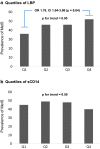Markers of metabolic endotoxemia as related to metabolic syndrome in an elderly male population at high cardiovascular risk: a cross-sectional study
- PMID: 30038669
- PMCID: PMC6054743
- DOI: 10.1186/s13098-018-0360-3
Markers of metabolic endotoxemia as related to metabolic syndrome in an elderly male population at high cardiovascular risk: a cross-sectional study
Abstract
Background: Metabolic syndrome (MetS) is a cluster of conditions that conjoined represents a 1.5-2.5 fold increased risk of developing cardiovascular disease (CVD). Recent studies have reported that gut dysbiosis and leakage of bacterial components, may contribute to the metabolic disturbances and systemic inflammation observed in subjects with MetS. Chronic exposure to lipopolysaccharide (LPS) has been shown to induce features of MetS in experimental studies. LPS interacts with the innate immune system, facilitated through LPS-binding protein (LBP) and the co-receptor CD14, both regarded as markers of gut leakage.
Purpose: We investigated whether circulating levels of LBP and sCD14 are associated with the presence of MetS and its components, and further any association with systemic inflammation.
Methods: We examined 482 men, aged between 65 and 75 years, all at high CVD risk. MetS criteria's according to the US National Cholesterol Education Program Adult Treatment Panel III were met in 182 subjects (38%).
Results: Levels of LBP and sCD14 did not differ between individuals with and without MetS. However, a trend towards increased risk of MetS through quartiles of LBP was observed (p = 0.05). Individuals in the highest quartile (Q4), had an increased risk of MetS (OR = 1.76, 95% CI (1.04-3.00), compared to the lowest quartile (Q1) (p = 0.04). With regard to the separate constituents of MetS, patients who met the waist circumference criterion had significant higher concentration of LBP compared to those who did not (p = 0.04). We also found a weak, but significant correlation between LBP and waist circumference (r = 0.10, p = 0.03). Moderate, yet significant correlations were observed between both LBP and sCD14 and several markers of systemic inflammation (r = 0.1-0.23; p < 0.001-0.04).
Conclusion: The trend for increased prevalence of MetS observed with increasing quartiles of LBP seems to be mainly driven by central obesity in our male cohort. The associations between LBP, sCD14 and systemic inflammation, indicate a potential role of the innate immune system in MetS.Trial registration CLINICALTRIALS.GOV, NCT00764010. Registered 01 October 2008-retrospectively registered, https://clinicaltrials.gov/ct2/show/NCT00764010?term=NCT00764010&rank=1.
Keywords: CD14; Central obesity; Chronic inflammation; Gut microbiota; Innate immunity; Lipopolysaccharide binding protein; Metabolic syndrome.
Figures
References
Associated data
LinkOut - more resources
Full Text Sources
Other Literature Sources
Medical
Research Materials
Miscellaneous


